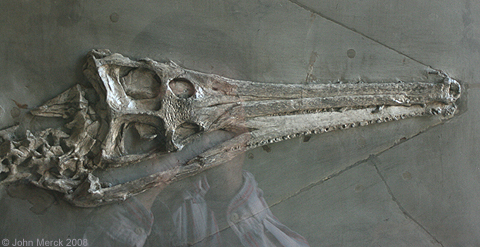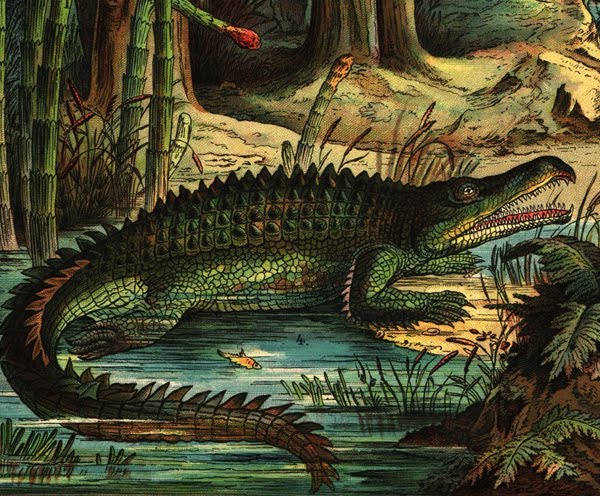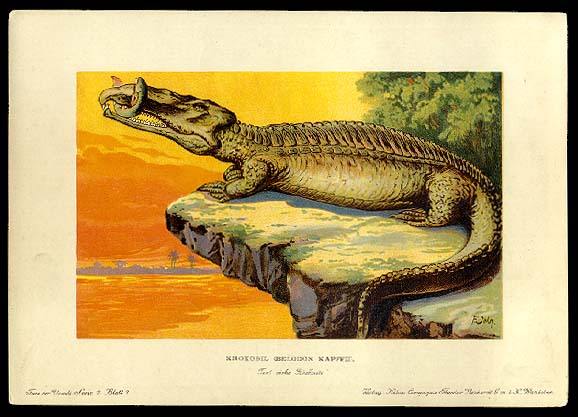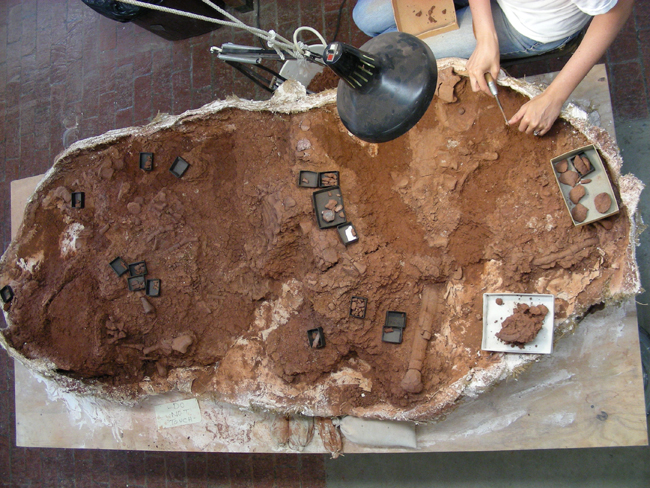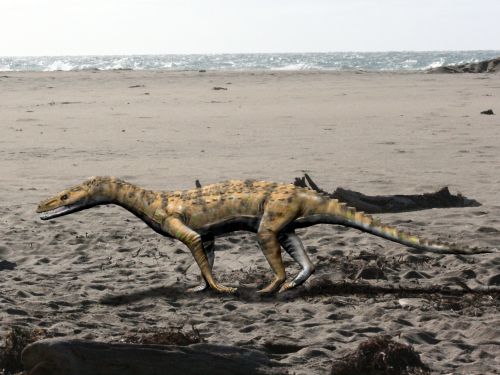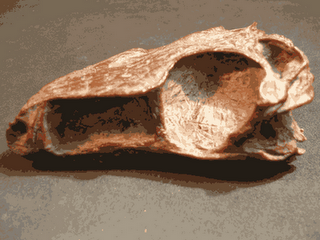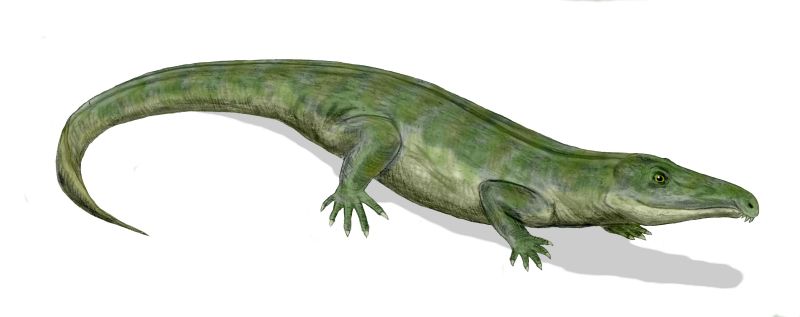[Recent Entries][Archive][Friends][User Info]
Below are the 16 most recent journal entries recorded in the "Сообщество, посвящённое ра" journal:| March 7th, 2012 | |
|---|---|
| 05:14 pm [industrialterro] [Link] |
Rutiodon Rutiodon ("Wrinkle tooth") is an extinct genus of archosaur belonging to the family Phytosauridae. It lived during the Late Triassic period, and was about 10 to 25 feet (3 to 8 meters) in length. The animal is known from fossils in Europe (Germany and Switzerland) as well as North America (Arizona, New Mexico, North Carolina, Texas, New York, New Jersey). Like other phytosaurs, Rutiodon strongly resembled a crocodile, but its nostrils were positioned far back on the head, close to the eyes, instead of at the tip of the snout. It had enlarged front teeth, and a relatively narrow jaw, somewhat resembling that of a modern gharial. This suggests that this carnivore probably caught fish and it may also have snatched land animals from the waterside. Also like modern crocodiles, its back, flanks, and tail were covered with bony armored plates.
Tags: Вымершие рептилии, Триас, архозавроморфы, архозавры, диапсиды, круротарзы, текодонты, фитозавры |
| 04:52 pm [industrialterro] [Link] |
Redondasaurus Redondasaurus is a genus of phytosaur from the Late Triassic of North America. Translated, the name Redondasaurus means "Redonda lizard," referring to the Redonda Formation of east-central New Mexico, USA. It was first named by Hunt & Lucas in 1993, and contains one species, R. gregorii. It is the youngest and most evolutionarily-advanced of the phytosaurs. Redondasaurus was a carnivore and measured from 10 to 12 meters in length, 1.5 meters of which made up the length of the head, and 1.5 meters in height. They could reach a weight of up to 26,000 lbs. It likely spent most of its time in lakes and rivers, and ambushed its prey, which consisted of fish, small reptiles, and possibly dinosaurs. There is little columnar enamel in the teeth of Redondasaurus. A recent phylogenetic analysis found that the genera Pseudopalatus, Mystriosuchus, Redondasaurus and Nicrosaurus were pseudopalatines.
Размеры тела в сравнении с человеком:
Ископаемые останки (1, 2, 3, 4, 5):
Tags: Вымершие рептилии, Триас, архозавроморфы, архозавры, диапсиды, круротарзы, текодонты, фитозавры |
| 04:43 pm [industrialterro] [Link] |
Nicrosaurus Nicrosaurus is an extinct genus of phytosaur reptile. Although it looked and probably lived like a crocodile, it was not closely related to these creatures, instead being a good example of parallel evolution. The main difference between Nicrosaurus (and all other phytosaurs) and real crocodiles was the position of the nostrils - Nicrosaurus's nostrils were placed directly in front of the forehead, whereas in crocodiles, the nostrils are positioned on the end of the snout. A recent phylogenetic analysis found that the genera Pseudopalatus, Mystriosuchus, Redondasaurus and Nicrosaurus were pseudopalatines.
Tags: Вымершие рептилии, Триас, архозавроморфы, архозавры, диапсиды, круротарзы, текодонты, фитозавры |
| 04:25 pm [industrialterro] [Link] |
Mystriosuchus Mystriosuchus (meaning "spoon-crocodile") is an extinct genus of phytosaur that lived in the Late Triassic (middle Norian) in Europe. It was first named by Eberhard Fraas in 1896, and includes two species: M. westphali (formerly M. plieningeri) and the type species, M. planirostris. Mystriosuchus planirostris measured about four metres long (13 ft), according to a complete skeleton which was found in 1995. The postcranial anatomy of the skeleton suggests that Mystriosuchus was more adapted to aquatic life than other known phytosaurs, while cranial morphology is suggestive of a primarily fish eating diet. Mystriosuchus used to placed in its own subfamily, Mystriosuchinae, however, recent research demonstratred that it belongs to the subfamily Pseudopalatinae, despite having several physical differences from most of the genera in this group. Originally considered to be a freshwater genus, a recent specimen from Northern Italy has shown that some Mystriosuchus specimens lived a completely marine life.
Tags: Вымершие рептилии, Триас, архозавроморфы, архозавры, диапсиды, круротарзы, текодонты, фитозавры |
| 03:53 pm [industrialterro] [Link] |
Leptosuchus Leptosuchus is an extinct genus of phytosaur with a complex taxonomical history. Fossils have been found from the Dockum Group and lower Chinle Formation outcropping in Texas, New Mexico, and Arizona and date back to the Carnian stage of the Late Triassic. Currently there are believed to be four species of Leptosuchus. All species share in common a similar position of the temporal arch below the skull roof and a posterior process of the squamosal that extends farther than the paroccipital process. The type species is L. crosbiensis, which was named in 1922 on the basis of material found from Texas. L. adamanensis was first described in 1930 as a species of Machaeroprosopus from the Blue Mesa Member of Petrified Forest National Park, along with the other two species, L. lithodendrorum and L. gregorii. It was not until the publication of a 1995 paper on tetrapods of southwestern United States that these species were recognized as belonging to the genus Leptosuchus. However, because of the distinctive size of the rostral crest in L. gregorii, it was assigned to its own genus, Smilosuchus, in that same paper. Despite this, L. gregorii has recently been seen as belonging to Leptosuchus, as it is believed that the large, complete crest was independently developed in this particular species. The close relation of Leptosuchus and Machaeroprosopus with Rutiodon has led some paleontologists to believe that the prior two were synonymous with Rutiodon, with the latter's name having seniority. Differing features seen in the three phytosaurs have been attributed to sexual dimorphism, differing growth stages, or individual variation, while similarities could be seen in the rostral crest and the position of the nares. Previously it was believed that these were different genera due to the geographical isolation that could be seen in North American phytosaurs; Leptosuchus remains were found primarily in southern localities while Rutiodon remains could be found in more eastern localities. Other studies concluded that it was synonymous with Machaeroprosopus or Phytosaurus. One recent study has again found Leptosuchus to be congeneric with Rutiodon, but since then another study has suggested that its type species R. carolinensis, while still very similar to Leptosuchus, is synonymous with Angistorhinus. Smilosuchus meaning "deadly-knife crocodile" is an extinct genus of phytosaur from the Late Triassic of North America. It was first described in 1995 as a replacement generic name for Leptosuchus gregorii. Because of the large rostral crest it possessed, it was considered to be distinct enough from other species of Leptosuchus (all of which had smaller and more restricted crests) to be within its own genus. Despite this, recent studies seem to suggest that Smilosuchus is congeneric with Leptosuchus, as the enlarged crest could have been independently developed in Leptosuchus.
Tags: Вымершие рептилии, Триас, архозавроморфы, архозавры, диапсиды, круротарзы, текодонты, фитозавры |
| 03:39 pm [industrialterro] [Link] |
Paleorhinus Paleorhinus was a genus of small phytosaur, a large order of semi-aquatic, crocodile-like animals that lived in the Late Triassic, specifically the earlier Late Carnian period. The reptiles lived throughout Europe, North America, and North Africa. This genus usually also includes the more appropriately named Parasuchus, which lived in India. Ebrachosuchus is an extinct genus of basal phytosaurid phytosaur. Fossils were first discovered from the Blasensandstein Formation near Ebrach, Germany, which dates back to the Carnian stage of the Late Triassic. The original holotype of E. neukami had a very elongate rostrum that was used to distinguish the genus from other phytosaurs. However, due to its many other similarities to the closely related Paleorhinus, Ebrachosuchus has since been considered to be synonymous with Paleorhinus. The rostrum length alone would not be enough to assign the original specimen of E. neukami to its own genus or subgenus, according to the authors of one paper proposing the synonymy.
Tags: Вымершие рептилии, Триас, архозавроморфы, архозавры, диапсиды, круротарзы, текодонты, фитозавры |
| March 6th, 2012 | |
| 07:59 pm [industrialterro] [Link] |
Belodon Belodon (meaning "arrow tooth") is a genus of phytosaur, a crocodile-like reptile that lived during the Triassic. Its fossils have been found in Europe and elsewhere. The type species, Belodon plieningeri, was named by prolific German paleontologist Christian Erich Hermann von Meyer in 1844. Many other species were also named, among them Belodon buceros (named by Edward Drinker Cope in 1881), Belodon kapfii (von Meyer, 1861), Belodon lepturus (Cope, 1870), Belodon priscus (originally described as Compsosaurus priscus by Joseph Leidy in 1856), Belodon scolopax (Cope, 1881), and Belodon validus (Othniel Charles Marsh, 1893). Some paleontologists of the late 19th and early 20th century believed Belodon was synonymous with Phytosaurus or Machaeroprosopus.
Tags: Вымершие рептилии, Триас, архозавроморфы, архозавры, диапсиды, круротарзы, текодонты, фитозавры |
| 07:28 pm [industrialterro] [Link] |
Pseudopalatus Pseudopalatus (meaning "false palate") is an extinct genus of pseudopalatine phytosaur. It was assigned to Parasuchia in 2005. Specimens have been found from Arizona and New Mexico and are of Norian age. Pseudopalatus lends its name to the family Pseudopalatinae, of which it is the type genus. Pseudopalatus was a relatively large pseudopalatine phytosaur with a skull up to 120 cm in length. It had a robust rostrum with a distinctive dorsal crest.
Ископаемые останки (1, 2, 3, 4):
Tags: Вымершие рептилии, Триас, архозавроморфы, архозавры, диапсиды, круротарзы, текодонты, фитозавры |
| 06:54 pm [industrialterro] [Link] |
Angistorhinus Angistorhinus (meaning "narrow snout" or "hook snout") is an extinct genus of phytosaur known from the Late Triassic period of Texas and Wyoming, USA. It was first named by Mehl in 1913 and the type species is Angistorhinus grandis. Other species from Texas and Wyoming, A. alticephalus (Stovall and Wharton, 1936), A. gracilis (Mehl, 1915) and A. maximus (Mehl, 1928), are cospecific with the type species. Angistorhinus is known from the holotype UC 631, partial skull and lower jaws recovered from the Popo Agie Formation, Chugwater Group, Wyoming and from the associated paratype UM 531, a partial skull, TMM 31098-1, skull and lower jaws and ROM 7977, partial skull and lower jaws, recovered from the 'Pre-Tecovas Horizon' in the Dockum Group, Texas. A possible second species, A. talainti is known from the Triassic of Morocco. In 1995, Long and Murry created the new combination, Angistorhinus megalodon by synonymy for Brachysuchus. Hungerbühler and Sues (2001) hypothesised that Angistorhinus is a junior synonym of Rutiodon. However, in 2010 Michelle R. Stocker retained the validity of Brachysuchus and of A. grandis. Фитоза́вры (Phytosauria) — монотипический отряд вымерших пресмыкающихся из позднего триаса, относимый к архозаврам и включаемый в сборную парафилетическую группу текодонтов, или ячеистозубых. Окаменелости обнаруживались в отложениях верхнего триаса на территории Западной Европы, Северной Америки, и Азии. Отряд фитозавров включает единственное семейство Phytosauridae представители которого обитали в пресноводных водоёмах, в основном питались рыбой. Внешне и деталями строения очень схожи с крокодилами. Однако, большинство учёных рассматривают данное сходство как конвергенцию, впрочем существует мнение о том, что фитозавры были предками крокодилов. Крупные животные с длиной тела 5—6 метров. Имели удлинённое рыло с отнесёнными далеко назад ноздрями и глазницами обращенными вверх. Задние лапы были незначительно длиннее передних. Обладали хорошо развитым кожным панцирем. The phytosaur skull was characterized by three distinct morphotypes, which relate to feeding and habits and not (as was once thought) evolutionary relationships. These skull patterns are linked to characteristics of the dentition; specifically the differentiation or similarity of the teeth along the jaws. Dolichorostral ("long snouted") types have a long, slender snout and a large number of conical teeth that are the same throughout. These were most likely piscivorous, able to capture fast slippery prey, but not so good at tackling a land animal. Some examples are Paleorhinus, Rutiodon carolinensis, and Mystriosuchus. At one time it was believed that Paleorhinus and Mystriosuchus belonged to a distinct group of phytosaurs (subfamily of family Mystriosuchinae/Mystriosuchidae Huene, 1915) characterised by this adaptation, but it is now known that Mystriosuchus is actually more closely related to Pseudopalatus, an "altirostral" form (Hungerbühler, 2002). Brachyrostral ("short snouted") forms are the opposite, they have a massive, broad snout, and a very strong skull and jaws, with the front teeth like fangs for holding the prey, and the rear teeth blade-like for slicing the meat into chunks that can easily be swallowed (an animal with different types of teeth like this is called heterodont). These were powerful animals specialised for feeding on strong struggling prey, such as terrestrial animals that come to the water to drink. Examples of this type are Nicrosaurus and Smilosuchus Altirostral ("high snouted") animals are intermediate between the two. They had heterodont dentition but not as extremely developed as the brachyrostral type. Angistorhinus and Pseudopalatus are typical examples here. These were most likely generalist feeders. Modern crocodilians exhibit a similar morphological diversity, for example the broad snouted altirostral alligator and the long snouted dolichorostral gavial. Phytosaurs were even better armoured than crocodiles, protected by heavy bony scutes (often found as fossils), and the belly reinforced with a dense arrangement of gastralia (abdominal ribs). Despite their great similarities in appearance and lifestyle, there are still a number of minor differences that distinguish phytosaurs from true crocodiles. For one thing, the phytosaur ankle structure is much more primitive than that of any crocodile. Also, phytosaurs lack the bony secondary palate that crocodiles have that enables them to breathe even when the mouth is full of water. It is possible however that phytosaurs had a fleshy palate, as many Mesozoic crocodiles are presumed to have had. Finally, and most noticeably, phytosaurs had nostrils placed near or above the level of the eyes, in contrast to crocodiles where the nostrils are near the end of the snout. This adaptation may have developed to allow them to breathe while the rest of the body was submerged. In a 2001 study of the biomechanics of the dinosaur Albertosaurus's teeth, William L. Abler also examined a phytosaur's teeth, finding that it had had serrations so fine that they resembled a crack in the tooth. Albertosaurus had similarly crack-like serrations, but, at the base of each serration Abler discovered a round void which would have functioned to distribute force over a larger surface area. This void, termed an ampulla, would hinder the ability of the "crack" formed by the serration to propagate through the tooth. The phytosaur was found to lack adaptations for preventing its dental "cracks" from propagating. Abler examined another sort of prehistoric predator, Dimetrodon, and found that it lacked adaptations for guarding against crack propagation as well.
Ископаемые останки (1, 2, 3, 4):
Tags: Вымершие рептилии, Триас, архозавроморфы, архозавры, диапсиды, круротарзы, текодонты, фитозавры |
| 05:37 pm [industrialterro] [Link] |
Turfanosuchus Turfanosuchus is a genus of archosauriform reptile which lived during the Middle Triassic of northwestern China. The type species, T. dabanensis, was described by C.C. Young in 1973, based on a partially complete but disarticulated fossil skeleton (IVPP V.32237). Young originally believed that the fossils came from an animal similar to Euparkeria, and assigned it to the family Euparkeriidae. The fossil, however, was not fully prepared. Subsequent analysis by Parrish in 1993 indicated that the fossils represented a suchian. In 2001, Xiao-Chun Wu (of the Institute of Vertebrate Paleontology and Paleoanthropology in Beijing) and Anthony Russell (of the University of Calgary) redescribed the fossil. Wu and Russell prepared the fossil, and noted the limb bones (femur and humerus) resembled those of Ticinosuchus and Euparkeria, though the calcaneum did not. Further preparation revealed a partial osteoderm. Wu and Russell concluded that Turfanosuchus was not a suchian nor even a member of the Crurotarsi. They also ruled out the possibility of a close relationship with Euparkeria. In 2010, paleontologists Martín Ezcurra, Agustina Lecuona, and Augustín Martinelli found Turfanosuchus to be a crurotarsan once again. This reassignment was based on the structure of the calcaneum, which is similar to that of other early crurotarsans, especially aetosaurs.
Tags: Вымершие рептилии, Триас, архозавроморфы, архозавры, диапсиды, круротарзы, текодонты |
| 05:13 pm [industrialterro] [Link] |
Gracilisuchus Gracilisuchus (meaning "graceful crocodile") is an extinct genus of tiny (30 cm long) crurotarsan (a group which includes the ancestors of crocodilians) from the Middle Triassic. It was a suchian close to the ancestry of crocodiles, and was at one time thought to be a dinosaur, but this hypothesis has since been rejected. Its fossils were first discovered in the 1970s. Этот род, представители которого встречались в Южной Америке в среднем триасе — один из самых древних в подотряде сфенозухий. В 1970-х его относили к орнитозухидам, в частности, в работах американского палеонтолога Альфреда Ромера, однако в 1981 Бринкман показал, что Gracilisuchus отличается от всех представителей вышеупомянутого семейства строением предплюсны и щёчной области, и предположил его родственные связи со Sphenosuchus и другими родами подотряда Sphenosuchia. По большинству признаков скелета Gracilisuchus напоминает текодонтов. Предплюсна нормального крокодилового типа, выпуклая латеральная поверхность таранной кости заходит в углубление пяточной. Пятый палец редуцирован, и проксимальный конец пятой метатарсалии не сохраняет примитивной крючковидной конфигурации. Лобковые кости длинные и, по-видимому, не участвуют в образовании вертлужной впадины. Коракоиды короткие, предглазничное окно, как и у большинства текодонтов, крупное и окружено обширным углублением. Строение щёчной области убедительно свидетельствует о родстве с крокодилами. Дорсальный конец квадратной кости загнут вперёд, и над ним нависает широкий край чешуйчатой кости. Теменные кости сзади сливаются. Дермальный панцирь располагается вдоль всей длины позвоночного столба. На один сегмент приходятся примерно две его пластинки. Элементы двух рядов зубчато соединены по средней линии. Шейные рёбра очень похожи на таковые у современных крокодилов: у них две отчётливо разделенные головки и короткий, направленный назад стержень, перекрытый спереди концом предшествующего ребра. Шейных позвонков семь, следующий за ними несёт ребра промежуточного строения. Несмотря на ряд сходных с крокодилами признаков в строении черепа, большинство особенностей скелета связывает Gracilisuchus с текодонтами, однако представителей этого рода нельзя отнести ни к одному из известных семейств этой группы.
Tags: Вымершие рептилии, Триас, архозавроморфы, архозавры, диапсиды, круротарзы, текодонты |
| February 19th, 2012 | |
| 06:01 pm [industrialterro] [Link] |
Doswellia Досвеллия (Doswellia kaltenbachi) — наземный хищный крокодилоподобный архозавр из позднего триаса (карнийский ярус) Северной Америки. Череп скульптурированный, очень низкий, с узкой удлинённой мордой. Развиты только верхние височные окна, глазницы обращены вверх. Имеются нёбные зубы, расположенные на птеригоиде. Длина черепа — 15 см, общая длина животного — около 2 м. Досвеллия обладала хорошо развитым спинным панцирем из остеодерм. Любопытной особенностью досвеллии были рёбра, изогнутые под углом почти 90°, так что туловище в грудной области было почти прямоугольным в поперечном сечении. В рамках кладистики досвеллия отнесена к группе Crurotarsi в качестве базального представителя и является единственным членом отдельного семейства Doswelliidae. Наличие у досвеллии панциря, возможно, означает, что она близка к другим панцирным архозаврам — растительноядным этозаврам. Однако, деталями строения спинного панциря и остеодерм досвеллия отличается от этозавров.
Tags: Вымершие рептилии, Триас, архозавроморфы, диапсиды, текодонты |
| 05:26 pm [industrialterro] [Link] |
Chasmatosuchus Chasmatosuchus was a large archosauriform reptile from the early Triassic period of South Africa and China. It is one of the earliest well-known archosauriforms. It was over 6 ft (2m) long and is thought to have behaved like a modern crocodile. Its mouth had two distinct features: the top of its jaw hooked downwards to aid in holding prey, and the upper palate was lined with a row of teeth—a primitive feature lost in later archosaurs. Хасматозух (Chasmatosuchus) — ближайший родич протерозуха из раннего триаса Приуралья (Верхняя Ветлуга, оленекский ярус). Известен по фрагментарным остаткам, длина черепа до 25-30 см. По-видимому, питался мелкой добычей, зубы сильно изогнуты назад, длинные, тонкие. Типовой вид — C. rossicus.
Tags: Вымершие рептилии, Триас, архозавроморфы, диапсиды, протерозухии, текодонты |
| 12:05 pm [industrialterro] [Link] |
Proterosuchus Proterosuchus is an extinct genus of Early Triassic proterosuchid archosaur. Remains have been found from South Africa and China. The genus Chasmatosaurus is considered a junior synonym of Proterosuchus, as all species of Chasmatosaurus, including C. aleandri, C. vanhoepeni, and C. yuani, have been reassigned to Proterosuchus. Elaphrosuchus has also been synonymized with Proterosuchus. The type species of Proterosuchus is P. fergusi. Two other species, P. ultimus and P. yuani, have also been named. Proterosuchus was one of the largest land reptile during the Early Triassic period, equivalent in size to today's Komodo dragons. It looked somewhat similar to a primitive crocodile, and shared many of their modern features like long jaws, powerful neck muscles, short legs and a lengthy tail, while possessing several features unique to proterosuchids such as its hook-shaped mouth. This jaw may have been an adaptation for catching prey, such as the dicynodont Lystrosaurus. Proterosuchus, like most modern crocodiles, is theorised to be an ambush predator, waiting for its prey to enter the water, at which point they would be attacked from below the surface, using the long, muscular tail for swimming and pushing through the water at speed. However, the animal also had stout legs that enabled it to walk comfortably at land. Being able to move between the land and the water was a great advantage, and enabled Proterosuchus to control its body temperature by sunbathing or cooling off in the water. Being an ambush predator like some present-day crocodiles meant that for the most part Proterosuchus remained in one environment for most of its life. This worked as an excellent means of conserving energy, even giving it the capability of surviving for perhaps months at a time without food. Although it could live and swim in the water, Proterosuchus may have preferred to hunt land animals rather than fish. Its eyes were located on the top of its head, allowing it to hide just under the surface of the water, where it would wait for animals to come and drink. When close enough, Proterosuchus would spring upwards and drag its victim into the water, drowning and then eating it. Comparisons between the scleral rings of Proterosuchus and modern birds and reptiles indicates that it may have been cathemeral, active throughout the day during short intervals, supporting the idea that early archosaurs adapted to dim light. However, as Proterosuchus may have been a polar animal, it likely lived under different lighting conditions from typical archosaurs and may not have inherited such adaptations from a common ancestor with archosaurs. Proterosuchus is an example of an early archosaur, the group which encompasses crocodiles, pterosaurs, dinosaurs, and birds. It was once believed to have been an ancestor to the crocodilians, but it is now known to be far more basal. Протерозух (Proterosuchus) — описан Р. Брумом из раннего триаса (зона Lystrosaurus) Южной Африки в 1903 году. Типовой вид — P. fergusi. Это же животное было позднее описано Хаутоном как хасматозавр (Chasmatosaurus vanhoepeni). Длина черепа от 15 до 50 см. Вероятно, остатки протерозухов принадлежали более мелким молодым особям, тогда как «хасматозавры» — более крупные животные. Череп низкий, с длинной мордой. Телосложение относительно легкое, зубы длинные, изогнутые назад. Вероятно, полуводный хищник, охотник за мелкой добычей. Близкий вид (P. yuani) описан в 1936 году из одновозрастных отложений Китая.
Tags: Вымершие рептилии, Триас, архозавроморфы, диапсиды, протерозухии, текодонты |
| 11:59 am [industrialterro] [Link] |
Sarmatosuchus Sarmatosuchus is an extinct genus of archosaurin reptile found in sediments of early Triassic age and know from a single species Sarmatosuchus otschevi. The holotype and only specimen was found in litified river deposits of the Donguz Formation exposed near the Berdyanka River, Orenburg region, Russia. The genus was originally included in the extinct family Proterosuchidae. However later analysis by David Gower and Andrei Sennikov, the describing author, has removed it from the Proterosuchidae and designated it a basal archosaur. Сарматозух (Sarmatosuchus otschevi) — один из самых последних представителей протерозухий. Описан в 1994 году А. Г. Сенниковым из ранних слоев среднего триаса (Донгуз) Приуралья. Череп высокий, выше, чем у архозавра, но менее массивный. Зубы довольно длинные, изогнутые назад. Длина достигала 3 метров. Мог быть охотником за крупной добычей.
Tags: Вымершие рептилии, Триас, архозавроморфы, архозавры, диапсиды, протерозухии, текодонты |
| December 7th, 2011 | |
| 08:54 pm [industrialterro] [Link] |
Archosaurus Archosaurus is an extinct genus of carnivorous archosauriform reptile. From the latest Permian of Russia and Poland, it is one of the earliest known archosauriformes. Протерозухии (Proterosuchia) — отряд примитивных архозавров (архозавроморфов). Наиболее примитивные из так называемых «текодонтов», находятся в основании ветви, ведущей к более развитым истинным архозаврам (крокодиломорфам, динозавроморфам). Череп длинный, низкий, с резко изогнутой вниз премаксиллой. Есть предглазничное окно, сохраняются надвисочная и заднетемнная кости, пинеальное отверстие. Поперечные выросты птеригоидов озублены. Зубные ячейки мелкие. Тело крокодилоподобное. 7 шейных позвонков, у некоторых шея довольно длинная. Длинные поперечные отростки туловищных позвонков. Лопатка и коракоид разделены. Конечности пятипалые, запястье слабо окостеневшее. Таз примитивный, без тиреоидного окна. Конечности широко расставлены, как у ящериц. Хвост длинный. Впервые появились в конце пермского периода, дожили до середины триаса. Большинство — полуводные хищники, охотники за мелкими позвоночными и рыбой. Некоторые представители могли быть охотниками за достаточно крупной добычей. Длина черепа до 50 см. Архозавр (Archosaurus rossicus) — единственный позднепермский представитель группы. Описан Л. П. Татариновым из самых верхних горизонтов перми Владимирской области (Вязники) в 1960 г. Череп относительно высокий, зубы мощные, слабо изогнутые, длина черепа до 40 см, общая длина взрослых особей до 2 метров. Это животное было наземным охотником за крупной добычей. В вязниковском комплексе нет горгонопсов и архозавр занял место крупнейшего хищника — охотника за парейазаврами и дицинодонтами. Неописанные протерозухии указываются и для поздней перми ЮАР. Крупная (до 2,5 м) специализированная рептилия - занимала вершину пищевой цепи поздней перми Европейской России. Массивное стопоходящее животное с относительно коротким черепом. Передняя часть верхней челюсти была загнута вниз, при этом первый зуб был самым крупным. Это позволяло архозавру крепко удерживать добычу. Коронки зубов кинжалообразно сжаты с боков и зазубрены по переднему и заднему краям. Жертвами архозавра были дицинодонты, цинодонты и проколофоны.
Tags: Вымершие рептилии, Пермь, архозавроморфы, диапсиды, протерозухии, текодонты |























